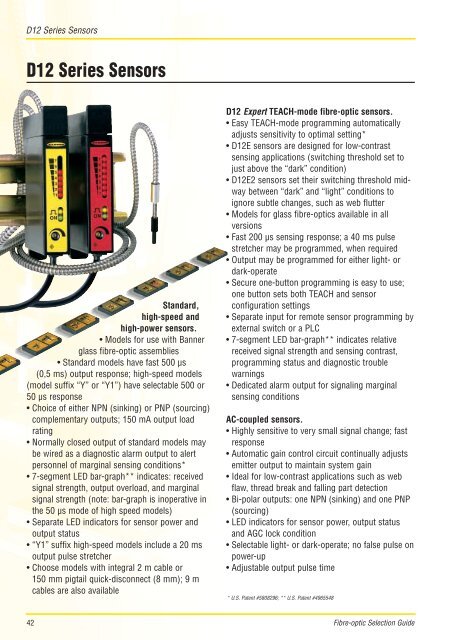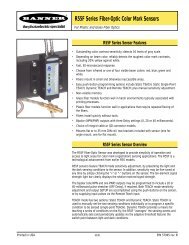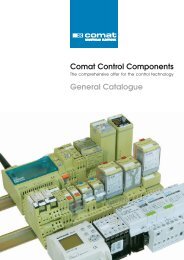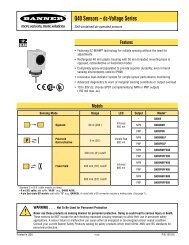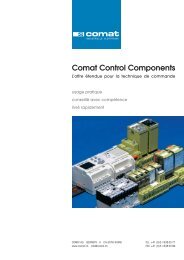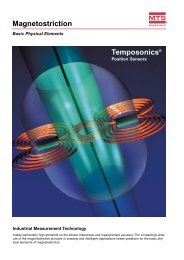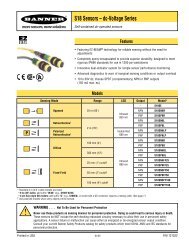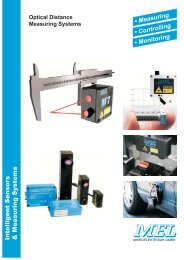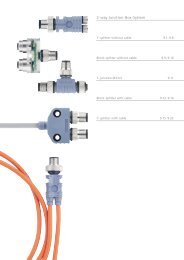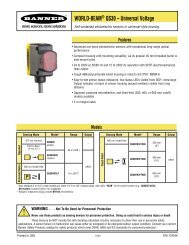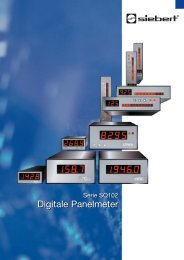Plastic Fibre-optic Specifications - Multiprox
Plastic Fibre-optic Specifications - Multiprox
Plastic Fibre-optic Specifications - Multiprox
You also want an ePaper? Increase the reach of your titles
YUMPU automatically turns print PDFs into web optimized ePapers that Google loves.
D12 Series Sensors<br />
D12 Series Sensors<br />
Standard,<br />
high-speed and<br />
high-power sensors.<br />
• Models for use with Banner<br />
glass fibre-<strong>optic</strong> assemblies<br />
• Standard models have fast 500 µs<br />
(0,5 ms) output response; high-speed models<br />
(model suffix “Y” or “Y1”) have selectable 500 or<br />
50 µs response<br />
• Choice of either NPN (sinking) or PNP (sourcing)<br />
complementary outputs; 150 mA output load<br />
rating<br />
• Normally closed output of standard models may<br />
be wired as a diagnostic alarm output to alert<br />
personnel of marginal sensing conditions*<br />
• 7-segment LED bar-graph** indicates: received<br />
signal strength, output overload, and marginal<br />
signal strength (note: bar-graph is inoperative in<br />
the 50 µs mode of high speed models)<br />
• Separate LED indicators for sensor power and<br />
output status<br />
• “Y1” suffix high-speed models include a 20 ms<br />
output pulse stretcher<br />
• Choose models with integral 2 m cable or<br />
150 mm pigtail quick-disconnect (8 mm); 9 m<br />
cables are also available<br />
D12 Expert TEACH-mode fibre-<strong>optic</strong> sensors.<br />
• Easy TEACH-mode programming automatically<br />
adjusts sensitivity to optimal setting*<br />
• D12E sensors are designed for low-contrast<br />
sensing applications (switching threshold set to<br />
just above the “dark” condition)<br />
• D12E2 sensors set their switching threshold midway<br />
between “dark” and “light” conditions to<br />
ignore subtle changes, such as web flutter<br />
• Models for glass fibre-<strong>optic</strong>s available in all<br />
versions<br />
• Fast 200 µs sensing response; a 40 ms pulse<br />
stretcher may be programmed, when required<br />
• Output may be programmed for either light- or<br />
dark-operate<br />
• Secure one-button programming is easy to use;<br />
one button sets both TEACH and sensor<br />
configuration settings<br />
• Separate input for remote sensor programming by<br />
external switch or a PLC<br />
• 7-segment LED bar-graph** indicates relative<br />
received signal strength and sensing contrast,<br />
programming status and diagnostic trouble<br />
warnings<br />
• Dedicated alarm output for signaling marginal<br />
sensing conditions<br />
AC-coupled sensors.<br />
• Highly sensitive to very small signal change; fast<br />
response<br />
• Automatic gain control circuit continually adjusts<br />
emitter output to maintain system gain<br />
• Ideal for low-contrast applications such as web<br />
flaw, thread break and falling part detection<br />
• Bi-polar outputs: one NPN (sinking) and one PNP<br />
(sourcing)<br />
• LED indicators for sensor power, output status<br />
and AGC lock condition<br />
• Selectable light- or dark-operate; no false pulse on<br />
power-up<br />
• Adjustable output pulse time<br />
* U.S. Patent #5808296; ** U.S. Patent #4965548<br />
42 <strong>Fibre</strong>-<strong>optic</strong> Selection Guide


